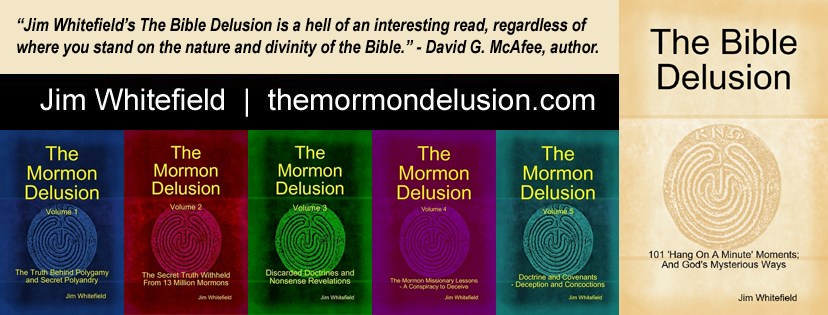Volume 4: The Mormon Missionary Lessons – A Conspiracy to Deceive.
Chapter 17:409-411. What is the role of the Book of Mormon?
…the Book of Mormon does not, after all, contain the ‘fullness’ of the Mormon gospel. In fact, outside of aspects that most other Christians believe, it really contains none of it at all. We might ask; where does the Book of Mormon speak of such things as the organisational structure of the Church – among many other things?
“The Book of Mormon contains the fullness of the gospel of Jesus Christ.”
Plural gods are not in the Book of Mormon.
Polygamy is expressly forbidden in the Book of Mormon.
God is not described as an exalted man.
Celestial marriage is not there.
Nephite men could not become Gods – at least God didn’t tell them that they could.
There are no ‘degrees of glory’, no Celestial, Terrestrial or Telestial kingdoms – but there is heaven and hell.
Baptism for the dead does not get a mention yet Mormons claim it biblical, citing 1 Corinthians 15:29. If it was good enough for people on one side of the world – then why not on the other?
Whilst there are ‘Priests’, there is no ‘Aaronic Priesthood’.
There is no eternal progression.
There are no temple ordinances (washing, anointing, endowment, sealing) and yet they supposedly built temples. Smith claimed the ordinances were performed from the time of Adam.
The Mormon concept of the Godhead is not there – but Smith’s monotheism shines through, page after page.
A ‘mother’ in heaven is absent from the book.
Each ‘dispensation’ had a ‘word of wisdom’ yet the Nephites did not. That is strange really, as Lehi and his family were Jews and according to the Book of Mormon they continued to practice Jewish traditions. That would include an entire health code which does not appear in the Book of Mormon.
The Mormon Church claim that the fullness of the gospel is contained in the Book of Mormon is a far cry from the truth. In reality, just the opposite is the case. In fact, some modern Mormon doctrine is completely contradicted in the Book of Mormon, as has been demonstrated several times in this volume.
Additionally, there are many things in the book which at first may appear innocuous enough but upon inspection are completely wrong when compared to known history – with or without faith. I covered many such things in TMD Vol. 2 but one thing I did not mention in that volume is an extraordinary idea mentioned in Mosiah 13:18-19.
Mosiah 13:18-19. But the seventh day, the sabbath of the Lord thy God, thou shalt not do any work, thou, nor thy son, nor thy daughter, thy man-servant, nor thy maid-servant, nor thy cattle, nor thy stranger that is within thy gates; 19. For insixdays the Lord made heaven and earth, and the sea, and all that in them is; wherefore the Lord blessed the sabbath day, and hallowed it.
I said this was extraordinary but at first glance the reader may wonder why. Surely the Old Testament confirms the basis of the above thinking. I agree that indeed it does – but that is not the problem. The problem is that all the cultures discovered in the Americas used anything but a seven day week. Calendars used in Mesoamerica vary, but none match the Old World calendar. We wouldn’t expect them to, unless we believed the people came from there. Then someone in the Americas should have had a seven day week and the absence of such is what causes the problem. The Maya had various calendars. One consisted of a two-hundred-and-sixty day cycle divided into thirteen periods of twenty days. Moreover, each day was represented by its own god. These people could hardly have ‘evolved’ from one God who created the world in seven days, to twenty gods, each with their own day of the ‘month’.
Another calendar did have three-hundred-and-sixty-five days in its cycle. However, it was also divided into periods of twenty days. A quick calculation will tell you there must have been eighteen of them, leaving five spare days. These surplus days were called the ‘sleep’ or the ‘rest’ of the year. No ‘seven day’ periods were used anywhere. Yet another calendar consisted of a 3276 day cycle. This was sub-divided into four ‘quadrants’ of 819 days – the product of 7, 9 and 13, which were all sacred numbers to the Maya. The ‘long count’ calendar simply counted days from the creation of the world – which in our own terms was 11 August 3114 BCE. None of that sounds much like Old World dating to me. (See: Schele, L&F. 1990:78).
No pre-Columbian Native American calendars have been discovered which match Old World traditions, providing yet more evidence that the Book of Mormon was nothing but a nineteenth century work of pure fiction.

